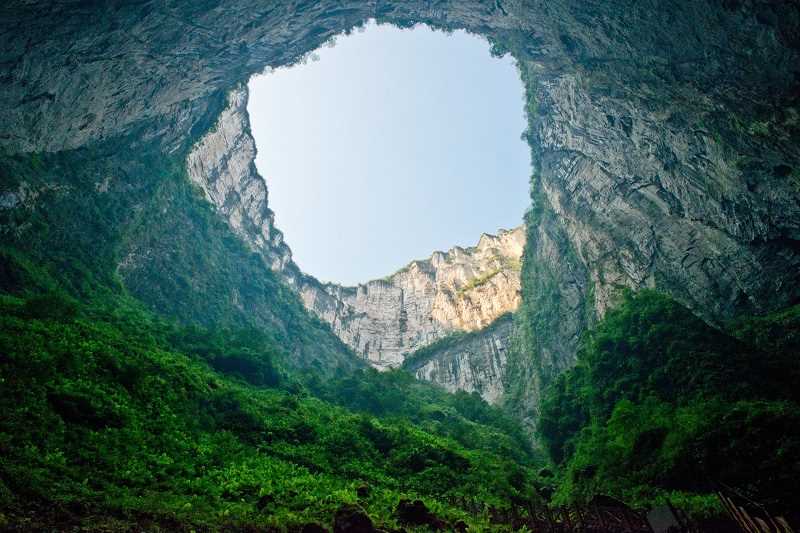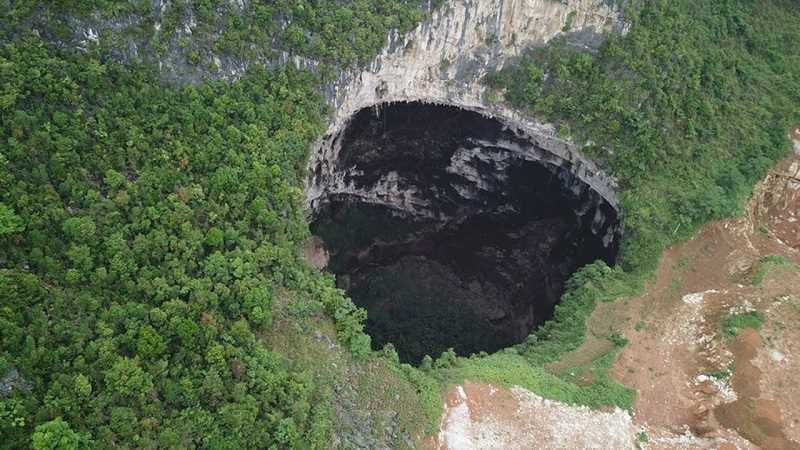A team of Chinese scientists has discovered a giant sinkhole in China with a forest at the bottom. The sinkhole is 192 m deep, according to a News Agency. This is located in the Quancim Autonomous Region of China.
In the sinkhole on the 6th, cavers discovered three entrance caves, as well as ancient trees 40 m high, extending their branches towards the sun’s rays.
The news excited George Veni, executive director of the National Cave and Karst Research Institute in the United States. The Institute of Karst Geology of the China Geological Survey, which explored this sinkhole, is a sister institute to NCKRI. An internationally renowned cave expert, he has authored numerous books.

For Veni, the discovery was not a surprise, as southern China has karst topography, which is conducive to the formation of impressive sinkholes and caves.
The dissolution of bedrock is the primary cause of karst relief and its landscapes, Veni explained.
Rainwater, which is slightly acidic, accumulates carbon dioxide as it travels through the soil, becoming more acidic. Then it moves and flows through the cracks in the bedrock, gradually expanding to form tunnels and openings. Over time, if a cave chamber becomes large enough, the ceiling can collapse, forming large sinkholes.
The new china 600 ft giant sinkhole contains an inner forest

Veni also says that geological and climatic differences, as well as other factors, can affect the way karst relief transforms on the surface. There are some very small sinkholes, just a meter or two in diameter, and some huge ones, with cavernous entrances and openings, like those found in China.
UNESCO has designated Quancim as a World Heritage Site due to its spectacular karst formations, such as sinkholes, rock pillars, and natural bridges.
The interior of the sinkhole in China is 306 m long and 150 m wide, according to Zhang Yuanhai, a senior engineer at the institute responsible for the exploration. The Mandarin word for sinkholes of this magnitude is “tiankeng,” or “heavenly well,” and the bottom of the sinkhole did indeed look like something out of this world.
During the expedition, Chen Lixin reported that the sinkhole’s undergrowth reached shoulder height. Veni notes that sinkholes and karst caves can be oases of life. The discovery that these caves contain species that have never been reported or described by scientists was not surprising to Lixin.
In a Texas cave, Veni said, tropical ferns grow in abundance. Apparently, bats migrating to South America and Central America carry its spores.
In addition to the giant sinkhole and the like being a haven for life, they also feature aquifers, which are underground stores of water.
Globally, 700 million people rely on karst aquifers for their water. But they are easily polluted.
The new giant sinkhole found in China discovery brings the number of sinkholes in the Leye County region to 30. The same researchers had previously discovered dozens of sinkholes in northeastern China’s Xianxim province and a set of interconnected sinkholes in Quancim.
Also Read: Why were Chainsaws Invented?: Fact Check

